-

新人教版高中英语必修1Unit 1 Teenage Life-Listening and Speaking & Listening and Talking教案
Step 2 Listening and Talking1. The teacher is advised to talk with their new students about the related topic: Boys and girls, do you know some structures to talk about future activities? Talking about future activitiesWe’ll …I plan to …There’ll be …I hope to …We’re going to …2. After their small talk, the teacher can move on by playing the listening and solve the following task.Underline the expressions in the sentences below Cao Jing and Max use to talk about the future.We’ll learn useful skills.I plan to improve my spoken English.There’ll be students from different schools.I hope to make new friends.We’ll talk about teenage life.I’ll learn to make a fire.There’ll be students from different countries at the camp.There’ll be some experts there to show us how to live in the wild.We’re going to learn about wildlife.I’m going to give a speech.I think I’m going to enjoy the activities.I think we’ll have a lot of fun.3. Work in groups. Plan a youth camp.Teacher make the Ss think of ideas for the camp. And they can use the questions below to get started. And have the Ss present their ideas for a youth camp to the class.●What kind of camp is it?●Who will be there?●What will they do?●What will they learn?
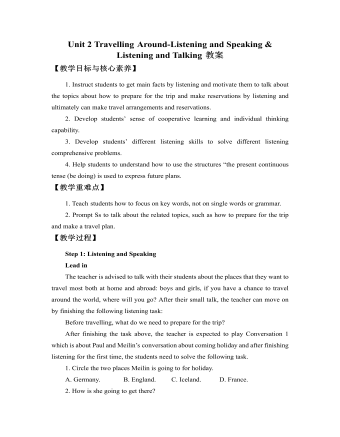
新人教版高中英语必修1Unit 2 Travelling Around-Listening and Speaking & Listening and Talking教案
【教学目标与核心素养】1. Instruct students to get main facts by listening and motivate them to talk about the topics about how to prepare for the trip and make reservations by listening and ultimately can make travel arrangements and reservations. 2. Develop students’ sense of cooperative learning and individual thinking capability. 3. Develop students’ different listening skills to solve different listening comprehensive problems.4. Help students to understand how to use the structures “the present continuous tense (be doing) is used to express future plans.【教学重难点】1. Teach students how to focus on key words, not on single words or grammar.2. Prompt Ss to talk about the related topics, such as how to prepare for the trip and make a travel plan.【教学过程】Step 1: Listening and SpeakingLead inThe teacher is advised to talk with their students about the places that they want to travel most both at home and abroad: boys and girls, if you have a chance to travel around the world, where will you go? After their small talk, the teacher can move on by finishing the following listening task:Before travelling, what do we need to prepare for the trip?
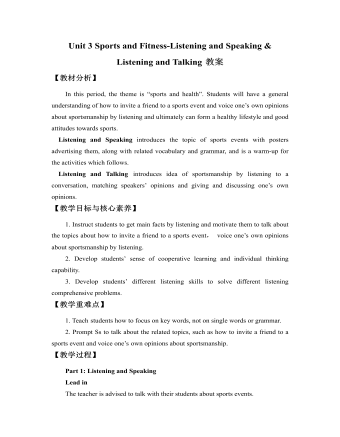
新人教版高中英语必修1Unit 3 Sports and Fitness-Listening and Speaking & Listening and Talking教案
Finally, after finishing the task above, the teacher is expected to instruct students to work in groups to finish the following project:Speaking ProjectWhat event or activity would you like to invite your friend to? Make a conversation with a partner.Ski Race: Zhangjiakou, a beautiful city in northern China, will host the Youth Ski Race in December.Track Meet: a great event for track –and –field lovers on 26 October.Gym Class: come and work out at a gym! You can make it.Part 2: Listening and Talking:The teacher is advised to talk with their new students about the related topic: Boys and girls , what do you think of sportsmanship? Let’s listen and find out:Play the listening and match each opinion with the right speaker. Who do you agree with? Why?Cao Jing _____________ Lily _____________ Max _____________A. An athlete should do his/her best to win.B. The girl should stop and help the other girl. Good sportsmanship is more important than wining!C. An athlete should think about honor and his/her fans if he/she is competing for his/her country.Listen again and circle the expressions that you hear in the conversation.
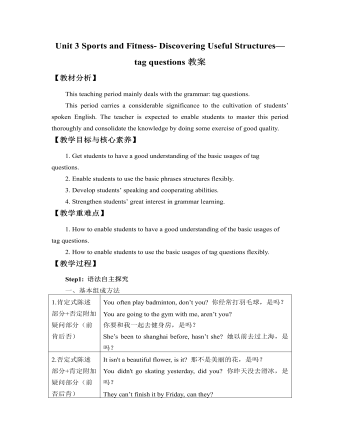
新人教版高中英语必修1Unit 3 Sports and Fitness- Discovering Useful Structures—tag questions教案
【教材分析】This teaching period mainly deals with the grammar: tag questions.This period carries a considerable significance to the cultivation of students’ spoken English. The teacher is expected to enable students to master this period thoroughly and consolidate the knowledge by doing some exercise of good quality.【教学目标与核心素养】1. Get students to have a good understanding of the basic usages of tag questions.2. Enable students to use the basic phrases structures flexibly.3. Develop students’ speaking and cooperating abilities.4. Strengthen students’ great interest in grammar learning.【教学重难点】1. How to enable students to have a good understanding of the basic usages of tag questions.2. How to enable students to use the basic usages of tag questions flexibly.【教学过程】Step1: 语法自主探究一、基本组成方法1.肯定式陈述部分+否定附加疑问部分(前肯后否) You often play badminton, don’t you? 你经常打羽毛球,是吗?You are going to the gym with me, aren’t you?你要和我一起去健身房,是吗?She’s been to shanghai before, hasn’t she? 她以前去过上海,是吗?2.否定式陈述部分+肯定附加疑问部分(前否后肯) It isn't a beautiful flower, is it? 那不是美丽的花,是吗?You didn't go skating yesterday, did you? 你昨天没去滑冰,是吗?They can’t finish it by Friday, can they?他们不能在星期五之前完成,是吗?
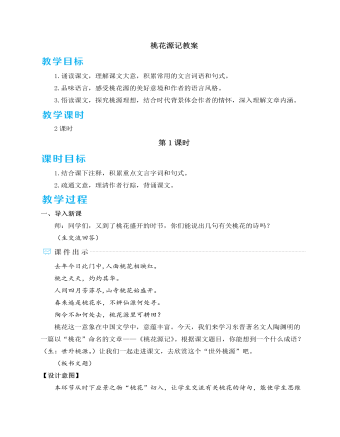
人教部编版语文八年级下册我一生中的重要抉择教案
五、总结存储1.教师总结这篇演讲词,作者用幽默诙谐的语言阐述了自己人生中的一个重要抉择——大力扶植年轻人。作者善于自我调侃,在自我解剖中进行了深入的分析,强调了扶植年轻人的重要性和必要性。演讲中列举了大量名人事例进行论证,使演讲具有很强的说服力。这篇演讲词展示了一位科学家精彩绝伦的语言魅力:不但有科学原理,而且有人生哲理;不但有学术的穿透力,而且有情感的震撼力;不但有理论的清晰度,而且有语言的幽默感——这一切构成了王选演讲的独特风采。我们在体会王选演讲魅力的同时,也领略到了他的人格魅力。2.布置作业(1)人的一生所做的重要抉择,如果与时代和国家紧密相连,意义会更加重大。我们在人生的关键阶段,如选择未来事业时,会做出怎样的抉择?请你写一段200字左右的演讲词,并在小组内演讲交流。(2)课外阅读王选的《我一生中的八个重要抉择》。
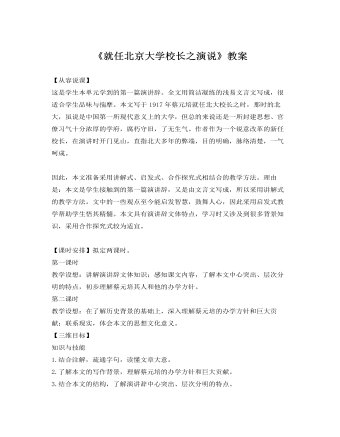
人教版高中语文《就任北京大学校长之演说》教案
蔡元培的道德风范和人格力量,具有震撼人心的作用,深为世人所钦仰。“人世楷模”“善良的社会和庄严的人生的模范”(国立音乐专科学校师生1936年1月《祝蔡孑民先生千秋诗》)的赞誉,对他来说绝非溢美之词。任鸿隽称他具有“处处为人无我的真精神”;“对人接物,似乎有两个原则,一个是尊重他人的人格,决不愿意以自己的语言和行动使人感到一点不快或不便,一个是承认他人的理性,以为天下事无不可以和平自由的方法互相了解或处理。”“但在公义一方面,蔡先生却是特立不屈、勇往直前、丝毫不退、毫不假借的斗士。”(重庆《中央日报》1940年3月24日)他的学生冯友兰也回忆说,在蔡先生身边,感同光风霁月,他的人格能造成一种气象。沐浴在这种气象之中,就不能不为他的人格所感化。蔡元培身居高位,一生廉洁,自奉俭朴,直至晚年仍是全家租赁房屋居住,他酷爱的书籍也分散在北平、上海、南京、杭州等地,没有一个归拢庋藏的地方。蔡元培这种真诚待人、无私奉献、光明磊落的精神,源于他对国家、对民族、对事业、对学生深深的眷恋和崇高的责任感。他的这种浩然正气和高尚道德情操,至今仍是公务人员的楷模。

人教版新目标初中英语七年级下册Where is the post office教案2篇
Period 2 (3a----Section B 2c)Preview(Pre-task): Key points: What laAdd another information about their pen pals----their language on the cardnguage does she/he speak?She/He speaks....Does she/he have any brothers and sisters? Does she/he speak English?Preview(Pre-task): Add another information about their pen pals----their language on the cardKey points: What language does she/he speak?She/He speaks....Does she/he have any brothers and sisters? Does she/he speak English?Step 1 Revision1.Revisionand dictation of the new words 2.Revise the drills they learned yesterday.(by pairwork and grammar exercise)Step 2 Leading-inT has a conversation with one student. The conversation is following:---Do you have a pen pal?---Yes, I do.---What's your pen pal's name? ---His/Her name is....---Where is your pen pal from? ---He/She is from...---Where does he/she live? ---He/She lives in....---What language does he/she speak?He/She speaks...Write the new words on the Bb. They are following: EnglishChineseJapaneseFrenchStep 3 LearnLearn the new words with the whole class.Finish 3a with the students3b Pairwork T still does an example with one student Then the Ss practise in pairs. The example is following:--Curry Muray is my pen pal. He is from the United States.---What language does he speak?

人教版新目标初中英语七年级下册I ’d like some noodles教案
教学过程Step 1: warming-up Sing a song---------“food and drink” Step 2: Revision1 Dictation2 Revise: What kind of noodles would you like?I’d like …What size bowl of noodles would you like?I’d like…Step 3: Presentation1 show pictures of food, ask students say the words.2 Students read the newspaper ad in 3a. Fill in blanks with words in the box. Then read the ad together, the teacher explains some difficult language points.3 Check the answers Step 4 PracticeAsk students to finish 3b in the same way according to 3a. Students read the short passage and fill in the blanks .At last, check the answers.Step 5 productionAsk students to write their own ad for dumplings, noodles, drinks, and other foods they know. Then ask students to read their partner’s ad. Then order food and drink from their partner.Step 6 Home workGroup work – make an ad about “food and drink”

人教版新目标初中英语七年级下册What do you think of game shows教案
五、教学Section B-2c1. Pair work: What do you think of the belt/sunglasses/…? What does your father/mother/… think of your scarf/belt…?2. Group work(1). Teacher shows some different kinds of school uniforms (制服)and asks : “ What do you think of your school uniforms? If you have a chance to choose your school uniforms, what kind would you like to choose?”(2). Discuss in groups.(3).Get some Ss to report in class.说明:这一步旨在让学生运用已有的语言知识谈论对事物的看法和意见,并简单阐明理由,培养学生的主动思维能力和运用英语的能力。六、教学拓展调查电视节目的收视率任务:调查你周围的人对现在各种电视节目的反响。活动过程:1.教师布置任务,让学生调查周围的人(包括他的亲戚朋友和邻居)喜欢收看哪方面的电视节目。2.学生进行调查活动,运用本单元所学的句型What do you think of….? (Why?)What's your favorite game shows?What do you think of talk show?I doesn’t mind it.I like it.I love it.I can’t stand it.3.记录下排在前10位的TV Program,填写调查表,比较其收视率。

人教版新目标初中英语八年级上册How was your school trip教案2篇
“Go for it!” is based on “Task-Based Language Teaching”. It adheres to “The authenticity principle”, “The form-function principle”, “The task dependency principle” and “The principle of learning by doing”. These principles all accord with the demands of curriculum focus.In and of Grade Seven (II), “Go for it!”, students have learned “The Simple Past Tense”. And it appears again in of Grade Eight (I). teaches students more about how to talk about events in the past. In addition, it gives affirmative and negative statements in the past tense, such as the sentence patterns “Did you see …?” “Were there …?” “Did you go …?” As the first part of Unit 8, Section A opens with a picture presenting the last school trip in the aquarium and continues with several step-by-step practice activities, which are all good for students to master “The Simple Past Tense”. Doing well in Section A will help students integrate the new target language with that in Section B. Thus, they can describe the events in the past freely and foster their own ability of reflecting and practicing. II. Teaching ObjectivesTeaching objective is the beginning and aim of teaching activities. According to the overall goal of the English elementary course--- improve students' synthetic ability of language application, which should be based on the development of students’ “Language knowledge”, “Language skills”, “Character building”, “Learning strategies” and “Cross-cultural awareness”. The teaching objectives are described as follows(I). Knowledge objectivesi. Master the simple past tense of regular and irregular verbsii. Recite the new words and expressions about the last school trip in the aquarium, including their pronunciation and intonation

人教版新目标初中英语八年级下册Have you ever been to an amusement park教案
(1)Have you ever been to …? Yes, I have. / Yes, I have ever been to …No, I haven’t. / No, I have never been to …(2)When did you go there? I went there last year. (3)I have never been to a water park. Neither have I. I have ever been to an amusement park. So have I. (4)How long have you been studying English? I’ve been studying English since nine o’clock. I’ve been studying English since I came back home. I’ve been studying English for five hours. (5)What’s that? It’s an amusement park in Japan. I’ve never been to an amusement park like it before. It’s fun to learn another language. Let’s go tonight. Isn’t this great?space museum, amusement park, water park, South America, Peru, Holland, European culture, tour guide, flight attendant, musical instrument, more than, be from, get to, take lessons, neither, discover, graduate, change
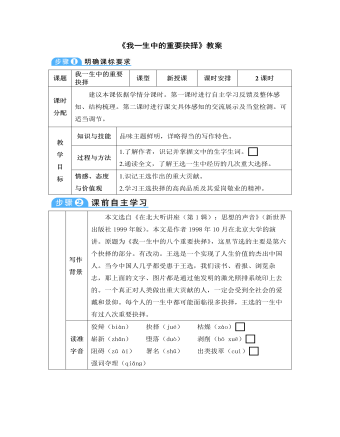
部编版语文八年级下册《我一生中的重要抉择》教案
(1)一个快落山的太阳,跟大家讲的,更多的是自己一生奋斗过来的体会。指61岁的老人。(2)加入人家说我是权威,也许还马马虎虎。作者自谦的说法,指成绩还过得去。(3)明明是一个过去时态,大家误认为是现在时态。指作者认为自己不适合再做权威了。(4)扶植年轻人我觉得是一种历史的潮流,当然我们要创造条件,就是把他们推到需要刺激的风口浪尖上。比喻重要的岗位或市场的前沿。【感悟精彩句子】1.所以我知道自己是一个下午四五点钟的太阳。各位呢,上午八九点钟的太阳,这是本科生;硕士生呢,九十点钟的太阳;博士生呢,十点十一点钟的太阳。比喻,拉近了与听众的距离,倍感亲切、期望和鼓舞。2.所以1992年前电视台采访我,我基本上都拒绝了。透过细节,体现了坚持不懈的科研精神。

部编版语文八年级上册《名著导读:红星照耀中国》教案
读序言,可以了解内容概要、写作缘由和过程,明确写书的纲领和目的。学生活动一:用5分钟时间浏览一篇序言(译者序和作者序任挑一篇),运用跳读法采集信息点,记录在便利贴上。并互动交流。小结:序言告知我们,“红星照耀中国”是作者在中国及世界局势即将发生大转变的关键一年,冒险来到西北红色区域采访后得出的结论。那么他在苏区见到了什么,听到了什么呢?让我们把视线焦点集中到他笔下那一群“不可征服”的革命青年身上。(二)读目录,了解主要内容及写作顺序1.学生浏览目录,说一说,这本书的写作顺序是怎么样的?主要写了哪几方面的内容?【方法指导】读目录,可以对作品的内容要点和篇章结构有所了解,迅速查阅到所需要的部分。明确:《红星照耀中国》是一部文笔优美的纪实性很强的报道性作品。作者按照事件发生的自然时间顺序真实记录了自1936年6月至10月在我国西北革命根据地进行实地采访的所见所闻。该书绝大部分素材来自作者采访的第一手资料,向全世界真实报道了中国和中国工农红军以及许多红军领袖、红军将领的情况。
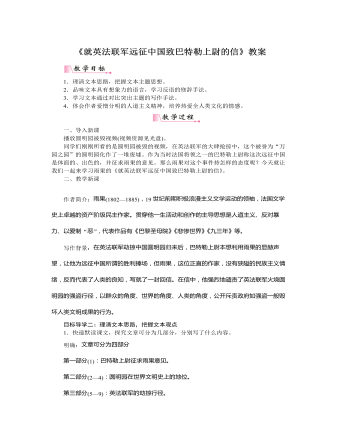
部编版语文九年级上册《就英法联军远征中国致巴特勒上尉的信》教案
3.作者是如何表达出自己的观点的?明确:作者首先以瑰丽的语言盛赞圆明园在人类文明中的地位,其后,又以比喻及反讽的修辞,将英法联军劫掠圆明园的罪行揭露而出,两者形成鲜明的对比,从而引出谴责英法联军远征中国行为的观点。目标导学三:了解作者心中的圆明园及英法联军的强盗行径1.作者是如何描述他心目中的圆明园的?明确:圆明园是幻想的某种规模巨大的典范,一座言语无法形容的建筑,某种恍若月宫的建筑。作者用大理石,玉石,青铜,瓷器,雪松,宝石,绸缎,神殿,后宫,城楼,神像,异兽,琉璃,珐琅,黄金,脂粉,一座座花园,一方方水池,一眼眼喷泉,成群的天鹅、朱鹭和孔雀等无数华贵的象征,铺就了一张华贵的想象画面,构成他心中的圆明园。正如他所说“总而言之,请你假设人类幻想的某种令人眼花缭乱的洞府,其外观是神庙,是宫殿,那就是这座园林”。

部编版语文九年级上册《中国人失掉自信力了吗》教案
一、导入新课我们已经学过鲁迅先生的不少文章,学过他的小说,看他用无数生动的形象表达他在时代里的“呐喊”与“彷徨”;学过他的散文,与他一同在失落中“朝花夕拾”,安静地回忆过往。今天,我们将学习鲁迅先生的一篇杂文,看他是如何作为民族斗士,将手中的笔,变成抨击敌人的枪。二、教学新课目标导学一:学习驳论,理清思路1.初读课文,找出对方的错误观点,并说说作者是怎样引出这一观点的。明确:对方的错误观点是“中国人失掉自信力了”。开篇以似乎确凿的事实为据,用一句话指出了三个阶段中“中国人”表现出来的三种不同的态度:盲目骄傲,夜郎自大;盲目崇拜,借助外援;今不如昔,祈求鬼神。即由自夸到崇洋,到自欺欺人、虚无渺茫的态度变化。因此有人“慨叹”:“中国人失掉自信力了。”这是论敌的论点。
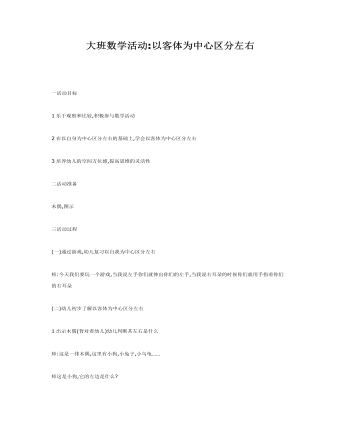
大班数学活动以客体为中心区分左右课件教案
2在以自身为中心区分左右的基础上,学会以客体为中心区分左右3培养幼儿的空间方位感,提高思维的灵活性二活动准备木偶,图示三活动过程(一)通过游戏,幼儿复习以自我为中心区分左右师:今天我们要玩一个游戏,当我说左手你们就伸出你们的左手,当我说右耳朵的时候你们就用手指着你们的右耳朵
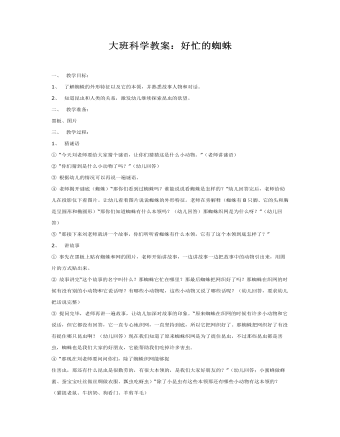
大班科学教案:好忙的蜘蛛
二、 教学准备: 黑板、图片 三、 教学过程: 1、 猜谜语 ① “今天刘老师要给大家猜个谜语,让你们猜猜这是什么小动物。”(老师讲谜语) ② “你们猜到是什么小动物了吗?”(幼儿回答) ③根据幼儿的情况可以再说一遍谜语。 ④老师揭开谜底(蜘蛛)“那你们看到过蜘蛛吗?谁能说说看蜘蛛是怎样的?”幼儿回答完后,老师给幼儿在投影仪下看图片。让幼儿看着图片说说蜘蛛的外形特征。老师在旁解释(蜘蛛有8只脚、它的头和胸是呈圆形和椭圆形)“那你们知道蜘蛛有什么本领吗?(幼儿回答)那蜘蛛织网是为什么呀?”(幼儿回答) ⑤ “那接下来刘老师就讲一个故事,你们听听看蜘蛛有什么本领,它有了这个本领到底怎样了?”
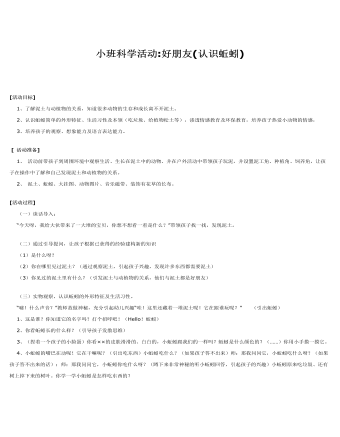
小班科学教案 好朋友
(一)谈话导入: “今天呀,我给大伙带来了一大堆的宝贝,你想不想看一看是什么?”带领孩子找一找,发现泥土。 (二)通过引导提问,让孩子根据已获得的经验建构新的知识 (1)是什么呀? (2)你在哪里见过泥土?(通过观察泥土,引起孩子兴趣,发现许多东西都需要泥土) (3)你见过的泥土里有什么?(引发泥土与动植物的关系,他们与泥土都是好朋友) (三)实物观察,认识蚯蚓的外形特征及生活习性。 “嘘!什么声音?”教师故做神秘,充分引起幼儿兴趣“哇!这里还藏着一堆泥土呢!它在跟谁玩呢?” (引出蚯蚓) 1、这是谁?你知道它的名字吗?打个招呼吧!(Hello!蚯蚓) 2、你看蚯蚓长的什么样?(引导孩子发散思维) 3、(捏着一个孩子的小脸蛋)你看××的皮肤滑滑的、白白的,小蚯蚓跟我们的一样吗?蚯蚓是什么颜色的?(……)你用小手摸一摸它。 4、小蚯蚓的嘴巴在动呢!它在干嘛呢?(引出吃东西)小蚯蚓吃什么?(如果孩子答不出来)师:那我问问它,小蚯蚓吃什么呀?(如果孩子答不出来的话):师:那我问问它,小蚯蚓你吃什么呀?(蹲下来非常神秘的听小蚯蚓回答,引起孩子的兴趣)小蚯蚓原来吃垃圾、还有树上掉下来的树叶。你学一学小蚯蚓是怎样吃东西的? (四)以生动形象的故事贯穿,让幼儿了解蚯蚓给植物松土的本领。
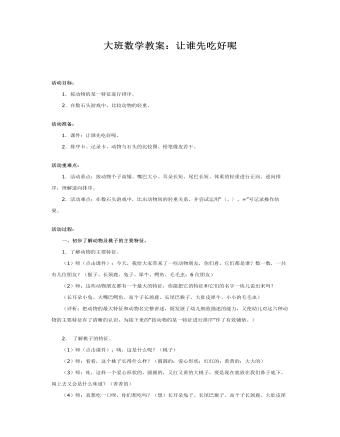
大班数学教案:让谁先吃好呢
活动准备:1.课件:让谁先吃好呢。2.排序卡、记录卡、动物与石头的比较图、铅笔橡皮若干。活动重难点:1.活动重点:按动物个子高矮、嘴巴大小、耳朵长短、尾巴长短、体重的轻重进行正向、逆向排序,理解逆向排序。2.活动难点:在数石头游戏中,比出动物间的轻重关系,并尝试运用“〈、〉、=”号记录操作结果。活动过程: 一、初步了解动物及桃子的主要特征。1.了解动物的主要特征。 (1)师(点击课件):今天,我给大家带来了一些动物朋友,你们看,它们都是谁?数一数,一共有几位朋友?(猴子、长颈鹿、兔子、犀牛、鳄鱼、毛毛虫;6位朋友) (2)师:这些动物朋友都有一个最大的特征,你能把它的特征和它们的名字一块儿说出来吗? (长耳朵小兔、大嘴巴鳄鱼、高个子长颈鹿、长尾巴猴子、大肚皮犀牛、小小的毛毛虫) (评析:把动物的最大特征和动物名完整讲述,既发展了幼儿细致描述的能力,又使幼儿对这六种动物的主要特征有了清晰的认识,为接下来的“按动物的某一特征进行排序”作了有效铺垫。)2.了解桃子的特征。 (1)师(点击课件):咦,这是什么呢?(桃子) (2)师:看看,这个桃子长得什么样?(圆圆的;爱心形状;红红的;黄黄的;大大的) (3)师:哇,这样一个爱心形状的、圆圆的,又红又黄的大桃子,要是现在就放在我们鼻子底下,闻上去又会是什么味道?(香香的) (4)师:真想吃一口呀,你们想吃吗?(想)长耳朵兔子、长尾巴猴子、高个子长颈鹿、大肚皮犀牛、大嘴巴鳄鱼、小小的毛毛虫和我们一样,看到这个桃子,馋得口水都快流出来了,都想先吃到这个大桃子。 (评析:对桃子形状、颜色、大小特征的讲述,以及对桃子气味的猜测,既“勾”起了幼儿品尝桃子的欲望,又“唤”起了他们对动物看到桃子后急切品尝心境的理解,适时、巧妙的引出了本次活动的一条暗藏线索“让谁先吃好呢?”。)二、按动物的某一特征排序。1.按动物高矮、大小、长短排序。 (1)按个子的高矮排序。A.师(点击课件):“按照个子的顺序吃怎么样?”长颈鹿把脖子挺得直直的,先说了一句。那就得先量量看,谁的个子最高了。毛毛虫说:“不能站在高的地方量,量的时候不能把尾巴算上”小兔说:“踮起脚来量也不行。”B.师(点击课件):瞧,他们每人都找了一棵大树开始量了起来。动物们和大树的什么比?(树干)C.师:它们一个个都紧贴着树干,认真的量着。小朋友,你们看出来了吗?谁最高?第二高是谁呢?第三高呢?接下来轮到谁?第五高?最矮的一个是谁呀?D.出示高矮排序图。E.讲述故事:“看见了吧?看见了吧?我的个子最高,所以得我先吃!”长颈鹿把脖子伸得长长的,刚要去咬那个又大又红的桃子。 (2)按嘴巴的大小排序。A.师(点击课件):“不行,这么大的桃子,当然得嘴巴最大的先吃了”鳄鱼张着一张大嘴,站了出来。到底谁的嘴巴最大?B.师(点击课件):“我的嘴巴大!”(犀牛声音)“谁说的!我的嘴巴才是最大的呢!”(鳄鱼声音)C.师:你们说,谁的嘴巴最大?(鳄鱼)E.讲述故事:“听见没,听见没有?我的嘴巴最大,当然是我先吃了!”鳄鱼使足了全身的劲儿,张大嘴巴,马上就要咬到这个又大又红的桃子了…… (3)按耳朵的长短排序。A.师(点击课件):“这么做不行!”蹦蹦跳跳的兔子竖着耳朵跑过来。B.师:欸,兔子会说什么呢?(谁耳朵长谁吃)C.师:那就是说得按什么顺序来吃桃子?(长短顺序)D.师:按什么的长短顺序,谁能完整的说一说?(按耳朵的长短顺序吃)E.师(点击课件):对,应该按照耳朵长短的顺序、谁的耳朵长谁先吃!那就比比,看看到底谁的耳朵最长吧。“看,还是我的耳朵最长吧!”小个子的兔子好不容易够到长颈鹿的脖子,说道。
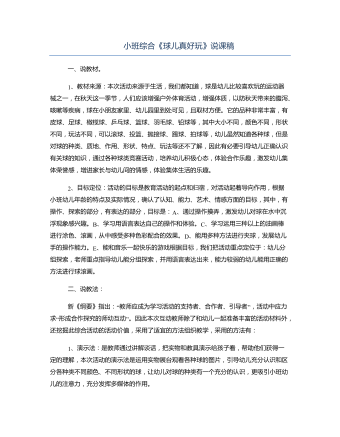
小班综合《球儿真好玩》说课稿
教材来源:本次活动来源于生活,我们都知道,球是幼儿比较喜欢玩的运动器械之一,在秋天这一季节,人们应该增强户外体育活动,增强体质,以防秋天带来的腹泻、咳嗽等疾病,球在小朋友家里、幼儿园里到处可见,且取材方便。它的品种非常丰富,有皮球、足球、橄榄球、乒乓球、篮球、羽毛球、铅球等,其中大小不同,颜色不同,形状不同,玩法不同,可以滚球、投篮、抛接球、踢球、拍球等,幼儿虽然知道各种球,但是对球的种类、质地、作用、形状、特点、玩法等还不了解,因此有必要引导幼儿正确认识有关球的知识,通过各种球类竞赛活动,培养幼儿积极心态,体验合作乐趣,激发幼儿集体荣誉感,增进家长与幼儿间的情感,体验集体生活的乐趣。
